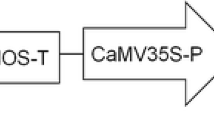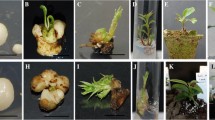Abstract
Protocols for genetic transformation of maritime pine (Pinus pinaster Sol. ex Aiton) embryogenic tissues were developed using the Agrobacterium C58pMP90/pPCV6NFGUS. This is the first report of Agrobacterium-mediated T-DNA integration in P. pinaster confirmed by Southern blot analysis. The omission of casein hydrolysate from culture medium during cocultivation and subsequent subculture was crucial to control Agrobacterium growth. Two different transformation protocols were compared: (1) bacterial drops were spread over embryogenic clumps; (2) a mixture of bacterial and embryogenic cell suspensions was plated on filter paper. The highest frequency of transformation (22 independent transformed lines per g fresh weight, for embryogenic clone 31/668/00) was obtained with Protocol 2. The same basic procedure allowed transformation of embryogenic cell suspensions, which was dependent on subculture age. From 52 hygromycin-resistant independent lines obtained, 47 showed stable uidA gene expression and were PCR-positive for uidA gene and 42 for hpt gene. No residual Agrobacterium was detected in the transformed lines. Transgene integration was achieved using both protocols, as confirmed by Southern hybridization. From 38 (90%) transformed lines successfully cryopreserved and recovered, 71% regrown replicates have maintained the frequency of cell aggregates and early-formed embryos with uidA expression. Maturation of 44 transformed lines gave rise to 3 mature somatic embryos, each one coming from a different transformed line. Our results show the high potential of Protocol 2 for application to different culture systems.
Similar content being viewed by others
Abbreviations
- AS:
-
Acetosyringone
- BAP:
-
6-Benzylaminopurine
- CH:
-
Casein hydrolysate
- (2,4-D):
-
2,4-Dichlorophenoxyacetic acid
- SE:
-
Somatic embryogenesis
References
Bercetche J, Pâques M (1995) Somatic embryogenesis in maritme pine. In: Jain S, Gupta P, Newton R (eds) Somatic embryogenesis in woody plants (vol 3). Kluwer Academic Publishers, Dordrecht, Boston, London, pp 221–242
Cervera M, Pina JA, Juárez J, Peña L (2000) A broad exploration of a transgenic population of citrus: stability of gene expression and phenotype. Theor Appl Genet 100:670–677
Dellaporta SL, Wood J, Hicks JB (1983) A plant DNA minipreparation: version II. Plant Mol Biol Rep 1:19–21
Direcção Geral das Florestas (2002) Inventário Florestal Nacional - 3a revisão. http://www.dgf.min-agricultura.pt/ifn/Tabelas.htm
Elleuch H, Gazeau C, David H, David A (1998) Cryopreservation does not affect the expression of a foreign sam gene in transgenic Papaver somniferum cells. Plant Cell Rep 18:94–98
Ellis DD, McCabe DE, McInnis S, Ramachandran R, Russel DR, Wallace KM, Martinell BJ, Roberts DR, Raffa KF, McCown BH (1993) Stable transformation of Picea glauca by particle acceleration. Bio/Technol 11:84–89
Gelvin SB (2003) Agrobacterium-mediated plant transformation: the biology behind the “gene-jockering” tool. Microbiol Mol Biol Rev 67:16–37
Grant JE, Cooper PA, Dale TM (2004) Transformed Pinus radiata from Agrobacterium tumefaciens-mediated transformation of cotyledons. Plant Cell Rep 22:894–902
Gupta PK, Durzan DJ (1985) Soot multiplication from mature trees of Douglas fir (Pseudotsuga menziesii) and sugar pine (Pinus lambertiana). Plant Cell Rep 4:177–179
Hansen G, Wright MS (1999) Recent advances in the transformation of plants. Trends Plant Sci 4:226–231
Jefferson RA (1987) Assaying chimeric genes in plants: the GUS gene system. Plant Mol Biol Rep 5:387–405
Klimaszewska K, Lachance D, Pelletier G, Lelu M-A, Séguin A (2001) Regeneration of transformed Picea glauca, P. mariana, and P. abies after cocultivation of embryogenic tissue with Agrobacterium tumefaciens. In Vitro Cell Dev Biol 37:748–755
Klimaszewska K, Lachance D, Bernier-Cardou M, Rutledge RG (2003) Transgene integration patterns and expression levels in transgenic tissue lines of Picea mariana, P. glauca and P. abies. Plant Cell Rep 21:1080–1087
Koncz C, Shell J (1986) The promoter of TL-DNA gene 5 controls the tissue-specific expression of chimeric genes carried by a novel type of Agrobacterium binary vector. Mol Gen Genet 204:383–396
Le VQ, Belles-Isles J, Dusabenyagasani M, Tremblay FM (2001) An improved procedure for production of white spruce (Picea glauca) transgenic plants using Agrobacterium tumefaciens. J Exp Bot 52:2089–2095
Lelu M-A, Bastien C, Drugeault A, Gouez M-L, Klimaszewska K (1999) Somatic embryogenesis and plantlet development in Pinus sylvestris and Pinus pinaster on medium with and without growth regulators. Physiol Plant 105:719–728
Levée V, Lelu M-A, Jouanin L, Cornu D, Pilate G (1997) Agrobacterium tumefaciens-mediated transformation of hybrid larch (Larix kaempferi × L. decidua) and transformed plant regeneration. Plant Cell Rep 16:680–685
Levée V, Garin E, Klimaszewska K, Séguin A (1999) Stable genetic transformation of white pine (Pinus strobus L.) after cocultivation of embryogenic tissues with Agrobacterium tumefaciens. Mol Breed 5:429–440
López M, Humara JM, Rodriguez R, Ordás RJ (2000) Factors involved in Agrobacterium tumefaciens-mediated gene transfer into Pinus nigra Arn. ssp. Salzmannii (Dunal) Franco. Euphytica 114:195–203
Marum L, Estêvão C, Oliveira MM, Amâncio S, Rodrigues L, Miguel C (2004) Recovery of cryopreserved embryogenic cultures of maritime pine—effect of cryoprotectant and suspension density. Cryoletters 25:363–374
Mathur J, Szabados L, Schaefer S, Grunenberg B, Lossow A, Jonas-Straube E, Schell J, Koncz C, Koncz-kalman Z (1998) Gene identification with sequenced T-DNA tags generated by transformation of Arabidopsis cell suspension. Plant J 13:707–716
Matzke AJM, Neuhuber F, Park Y-D, Ambros PF and Matzke MA (1994) Homology dependent gene silencing in transgenic plants: epistatic silencing loci contain multiple copies of methylated transgenes. Mol Gen Genet 244:219–229
Matzke AJ, Matzke MA (1998) Position effects and epigenetic silencing of plant transgenes. Curr Opin Plant Biol 1:142–148
McNutt J, Rennel J (1997) Future of fiber in tomorrow’s world. Pulp Paper Int 39:48–51
Miguel C, Gonçalves S, Tereso S, Marum L, Oliveira MM (2004) Somatic embryogenesis from 20 open-pollinated seed families of Portuguese plus trees of maritime pine. Plant Cell Tiss Org Cult 76:121–130
Sambrook J, Russell DJ (2001) Molecular cloning: a laboratory manual (vol 2). Cold Spring Harbor Laboratory Press, Cold Spring Harbor, New York, pp␣9.31–9.33
Stam M, Joseph NM, Kooter M (1997) The silence of genes in transgenic plants. Ann Bot 79:3–12
Tang W, Guo ZC and Ouyang F (2001) Plant regeneration from embryogenic cultures initiated from mature loblolly pine zygotic embryos. In Vitro Cell Dev Biol—Plant 37:558–563
Tang W and Newton RJ (2004) Regulated gene expression by glucocorticoids in cultured Virginia pine (Pinus virginiana Mill.) cells. J Exp Bot 402:1499–1508
Tefler M and Casse-Delbart F (1987) Agrobacterium rhizogenes as the vector for transforming higher plants. Microbiol Sci 4:24–28
Tereso S, Zoglauer K, Miguel C, Oliveira MM (2003) Establishing a genetic transformation system in Pinus pinaster. In: Espinel S, Barreto Y, Ritter E (eds) Sustainable forestry, wood products and biotechnology. DFA-AFA Press, Vitoria-Gasteiz, Spain, pp 195–204
Tian L-N, Charest PJ, Séguin A, Rutledge RG (2000) Hygromycin resistance is an effective selectable marker for biolistic transformation of black spruce (Picea mariana). Plant Cell Rep 19:358–362
Trontin J-F, Harvengt L, Garin E, Lopez-Vernaza M, Arancio L, Hoebeke J, Canlet F, Pâques M (2002). Towards genetic engineering of maritime pine (Pinus pinaster Ait.). Ann For Sci 59: 687–697
Walter C, Grace LJ, Wagner A, White DWR, Walden AR, Donaldson SS, Hinton H, Gardner RC, Smith DR (1998) Stable transformation and regeneration of transgenic plants of Pinus radiata D. Don. Plant Cell Rep 17:460–468
Wenck AR, Quinn M, Whetten RW, Pullman G, Sederoff R. (1999) High-efficiency Agrobacterium-mediated transformation of Norway spruce (Picea abies) and loblolly pine (Pinus taeda). Plant Mol Biol 39:407–416
Acknowledgements
Dr. Adi Rahmat from Angewandte Botanik und Arboretum, Institut für Biologie, Humboldt-Universität zu Berlin, Berlin, Germany is gratefully acknowledged for the technical support in the transformation experiments. Thanks are also due to Catarina Estêvão from IBET (Oeiras, Portugal) for the technical assistance in cryopreservation of the transformed lines. This research was supported by Fundação para a Ciência e Tecnologia (FCT) and the III Framework Programme of the European Community, through a PhD grant SFRH/BD/1186/2000 to Susana Tereso. Estação Florestal Nacional (EFN) is acknowledged for making plant material available.
Author information
Authors and Affiliations
Corresponding author
Rights and permissions
About this article
Cite this article
Tereso, S., Miguel, C., Zoglauer, K. et al. Stable Agrobacterium-mediated transformation of embryogenic tissues from Pinus pinaster Portuguese genotypes. Plant Growth Regul 50, 57–68 (2006). https://doi.org/10.1007/s10725-006-9126-2
Published:
Issue Date:
DOI: https://doi.org/10.1007/s10725-006-9126-2




